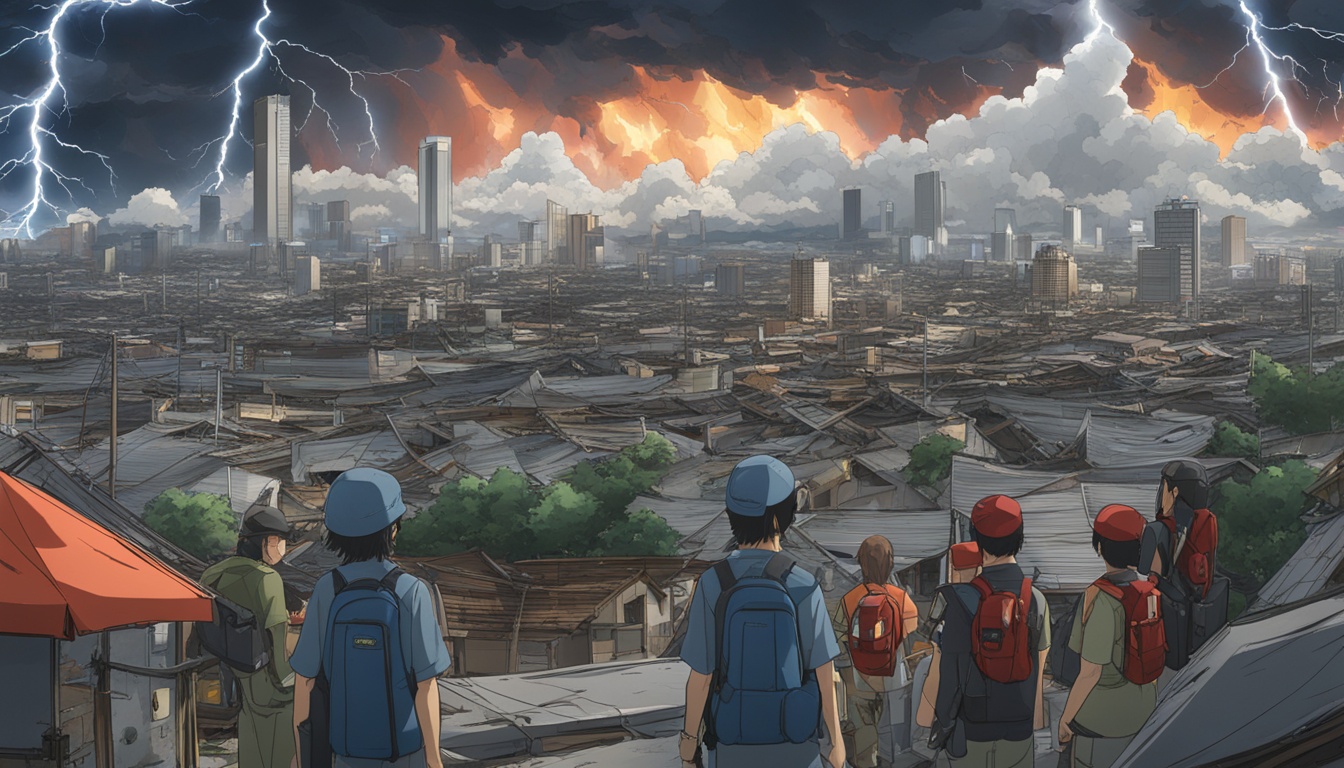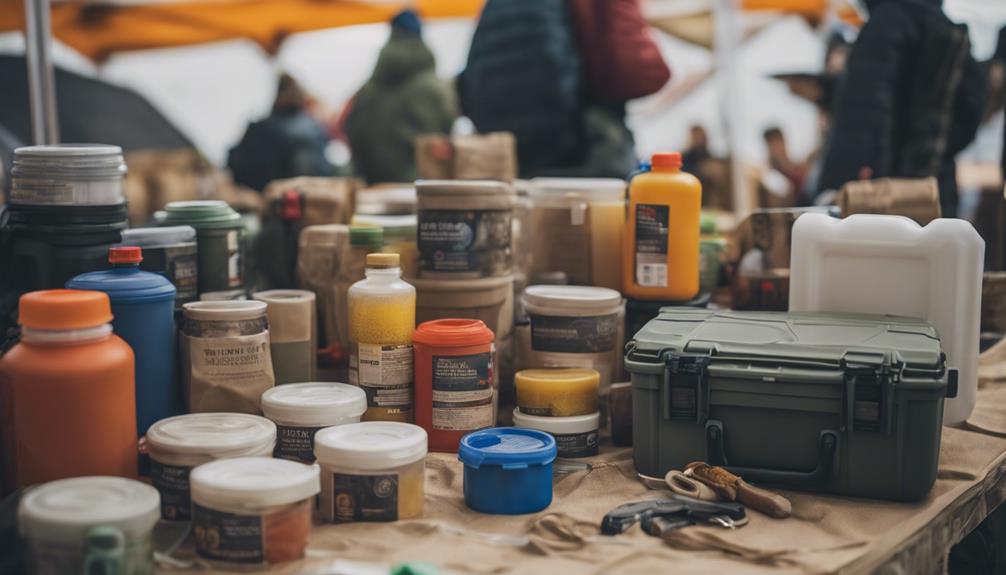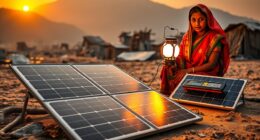Did you know that natural disasters cause about $23.46 billion in damage yearly in the US1? It’s key for homeowners to keep their homes and loved ones safe. Being ready for surprises from Mother Nature is also important. This article offers needed safety advice for various natural catastrophes. We’ll help you know the dangers and what you can do to stay safe.
Key Takeaways:
- Understanding natural disasters is essential for homeowners to protect their investments and loved ones.
- Weather-related damage in the United States amounts to a staggering $23.46 billion annually1.
- This article provides safety tips for various natural disasters, including hail storms, tornadoes, hurricanes, floods, and wildfires.
- By taking precautionary measures and being prepared, you can reduce the risks associated with natural disasters.
- Stay informed about local emergency plans and follow experts’ advice in the event of a natural disaster.
Safety Tips for Hail Storms
Hailstorms can damage your property, including your roof, windows, and car. Here are some tips to keep safe and protect your things during hailstorms:
1. Stay Indoors and Seek Shelter
It’s critical to stay inside during a hailstorm. Find a strong building or go to your basement. This reduces your risk of getting hit by hail. Stay inside until the storm is over and it’s safe to go out.
2. Avoid Bringing Possessions with You
Don’t bring items like umbrellas or sports gear to the shelter spot. In strong winds, these can fly around and cause harm or break things.
3. Protect Your Vehicle
Put your car in a garage or under cover if you can. This keeps your vehicle safe from hail. If you don’t have a covered spot, place blankets or car covers over your car to shield it from hailstones.
4. Store Outdoor Furniture Indoors
Move your outdoor furniture inside before the hail starts. Fix any items outside that can’t be moved to avoid them being damaged or blown away.
5. Protect Windows and Doors
Think about getting strong windows and doors that can resist hail. This can lessen or even stop hail damage, keeping your home safe during storms.
6. Assess Property Damage after the Storm
Once the hailstorm is done, look over your home for damage. Check the roof and gutters, and look at your windows. Fixing damage quickly can prevent more issues and keep your home safe.
| Statistical Data | Reference |
|---|---|
| Between 2000 and 2019, hail related damages averaged between $8 million and $14 million per year. | 2 |
| Nebraska, Colorado, and Wyoming traditionally have the most hailstorms each year. | 2 |
| Texas had the largest number of hail claims from 2017 to 2019. | 2 |
| In 2019, more than 7.1 million US properties were affected by 1 or more damaging hail events. | 2 |
| Hailstorms can result in millions—and sometimes billions—of dollars in damages to commercial roofs, siding, and outdoor and roof-mounted equipment. | 3 |
| Significant hailstorms threaten various building structures and contents leading to roof coverings being shredded and water damage to ceilings, walls, floors, appliances, furnishings, and contents. | 3 |
By following these tips and being prepared, you can better protect yourself and your belongings during hailstorms. Always stay updated with the weather and act quickly to keep safe and reduce damage.
Safety Tips for Tornadoes and High Winds
Tornadoes are powerful and can destroy a lot. They can damage homes and put lives at risk. Being ready and taking the right safety steps are key.
To keep your home safe from tornadoes, anchor down large appliances. Make sure your garage doors are strong and your siding can handle big winds. Doing these things helps lessen the damage tornadoes and winds can cause.
Place heavy items low in your home. This stops them from flying around in a tornado. Store dangerous chemicals away from your food and water to prevent them from mixing if a tornado hits.
Windows and doors are weak spots during tornadoes. Protect them with storm shutters or impact-resistant windows. Keep your roof in good shape to fight off high winds. Also, cut down any trees that might fall on your house during a storm.

Finding a safe place like a basement is crucial when a tornado comes. The CDC says this is the best thing to do. Head injuries are a big reason people die in tornadoes4. Some people might want to wear helmets for extra safety. But don’t waste time looking for a helmet when you should be getting to safety4. Instead, keep helmets handy as part of your tornado readiness kit4.
Getting ready for tornadoes and winds is very important. Practice safety drills with your family so everyone knows what to do. Keep a Go-Kit with emergency supplies for three days. Have a Stay-at-Home Kit with supplies for two weeks. Put a month’s supply of medicines in a child-safe place. Keep your important papers where you can grab them quickly5.
If you hear a Tornado Warning, get to a safe place fast. Wear thick shoes and gloves when cleaning up afterwards to avoid injuries5. But, kids should not help with cleanup5. Watch out for carbon monoxide poisoning from using certain machines indoors without enough air5.
After tornadoes, stay safe and look after your health. If you’re feeling overwhelmed, call the Disaster Distress Helpline at 1-800-985-59905. Eating well and getting plenty of rest also help with stress after a disaster5.
Safety Tips for Hurricanes
Hurricanes are mighty and can wreck homes. They also put people at risk. It’s key to be ready and to know how to stay safe when a hurricane comes.
Here are some must-know safety tips:
- Make an escape plan early. Know where to go and how to get there fast.
- Keep a disaster kit ready. It should have food that won’t spoil, water, medicines, flashlights, batteries, and a first-aid kit.
- Tie down or bring inside anything that wind could pick up. Trim trees, strengthen garage doors, and make windows and doors more secure.
- If you live where it might flood, put stuff high up. This could keep your things from getting ruined by water.
- List your valuables and note any damage before the storm. This info will help with insurance claims later6.
- Watch the weather news. Know what’s happening by listening to the National Weather Service. A Hurricane Watch means trouble might come in 48 hours. A Hurricane Warning means it’s almost certain in 24 hours67.
- Listen to safety officers and leave right away if they say to. Your safety is what’s most important. my li>
- Shut off gas tanks and be ready for the power to go out. Have candles or flashlights and maybe a backup power source.
- Wait until the storm is over to check for damage. Don’t touch wet electrical stuff to avoid shock. Check your water for safety before drinking, and record any damage for insurance.
- Throw out food that might be bad. This includes anything touched by floodwater or not kept cold. Watch out for dangerous things like broken glass and dirty water after the storm8.
Being prepared and following these safety steps can help lessen the harm a hurricane could do. Always stay alert and prioritize safety.

Safety Tips for Floods
Floods can greatly damage property and risk lives. Being prepared and following safety tips is vital during a flood. Here are key safety tips to remember:
- Stay informed: Keep up with weather reports and heed local advisories and evacuation orders.
- Create an evacuation plan: Know the safe paths to higher ground and share your plan with family members9.
- Store valuables in a watertight safe: Keep documents and valuable items safe from floodwaters.
- Back up important documents: Save digital copies of key documents in secure cloud storage or a waterproof container.
- Stock emergency and first-aid supplies: Have an emergency kit ready with flashlights, batteries, food, water, and medicine.
- Purchase flood insurance: Most renter and homeowner policies don’t cover flood losses. Flood insurance through the NFIP can protect your property9.
- Prepare your home: Keep gutters and downspouts clear for water to flow away. Barrier your home against floodwaters with sandbags10.
- Avoid walking or driving through floodwaters: Six inches of water can make you fall. Two feet of water can sweep away most vehicles, including SUVs and trucks11.
- Assume downed power lines are live: Electrocution is a big risk during floods. Stay far from downed lines and report them.
- Boil water before drinking: Boil tap water for at least one minute if its safety isn’t confirmed by local authorities.
- Dispose of flood-contaminated food: Toss any food touched by floodwaters to avoid disease.
- Clean and disinfect flooded areas: Use bleach solution to disinfect floors and walls. Throw out or professionally clean soaked items9.
- Be aware of mold growth: Mold is a health risk post-flooding. Watch for mold in hidden spots and take steps to prevent it.
To better prepare for floods, follow these tips to safeguard yourself, your loved ones, and your home. Key steps include staying informed, making an evacuation plan, and getting flood insurance.

| Statistical Data | Source |
|---|---|
| Flooding is the most common hazard in Massachusetts9. | Link 1 |
| Flood losses are not typically covered under renter and homeowner’s insurance policies9. | Link 1 |
| There’s a 30-day waiting period for NFIP flood insurance to start9. | Link 1 |
| Most drownings happen in flash floods; six inches of fast-moving water can knock a person down9. | Link 1 |
| Cars can be swept away by just two feet of moving water9. | Link 1 |
| Floods cause more severe-weather damage than any other event10. | Link 2 |
| 10 flood safety tips given for preparation and safety10. | Link 2 |
| Just 1 inch of water in your home can cause $25,000 in damage10. | Link 2 |
| FEMA’s flood map can show if your home is at flood risk10. | Link 2 |
| Six inches of moving water can knock you off your feet11. | Link 3 |
| 1 foot of water can float many vehicles11. | Link 3 |
| 2 feet of rushing water can move most vehicles, including SUVs and trucks11. | Link 3 |
Safety Tips for Wildfires
Wildfires can destroy homes and harm the environment. It’s very important to follow safety tips to reduce wildfires risks. These steps can protect you and your property.
Create a Fire-Resistant Zone
To protect your home from wildfires, create a fire-resistant area around it. Remove all flammable items like leaves and dry plants at least 30 feet away. This barrier can stop wildfires from reaching your property and lower ignition risks12.
Keep trees and bushes trimmed and get rid of the trimmings. Also, don’t keep firewood or propane tanks near your home or in the fire-safe zone.
Be Prepared for Emergency Situations
Wildfires can spread rapidly, giving you little time to leave. Have an emergency kit ready in your bag or car. Your kit should have food, water, medicine, and first aid supplies for at least three days. Always keep your phone charged to get emergency updates1213.
Protect Yourself from Smoke Inhalation
Smoke from wildfires can be very harmful. Wear an N95 mask to filter out dangerous particles. If you can’t get a mask, a wet cloth over your face can help protect you. But, always listen to the local authorities and evacuate if told to do so1213.
Follow Evacuation Orders and Stay Informed
It’s important to leave quickly when evacuation orders are given. This helps you stay safe and lets firefighters do their job. Keep an eye on local news for updates on the wildfire1314.
Document Property Damage and Contact Insurance
If a wildfire damages your property, record all damage safely. Take photos or videos before cleaning up or repairing anything. Then, call your insurance company to report the damage and get help with your claim12.
Wildfires are unpredictable and destructive. But by following these tips, you can prevent damage, protect your loved ones, and stay safe. Always be informed and ready for emergencies.
| Wildfire Safety Meaures | Refrences |
|---|---|
| Create a fire-resistant area | 1 |
| Be ready for urgent situations | 1, 2 |
| Shield yourself from harmful smoke | 1, 2 |
| Heed evacuation instructions and keep updated | 2, 3 |
| Record any property harm and alert insurance | 1 |

Evacuation Tips from FEMA
When disasters strike quickly, you might need to leave your area or stay home to stay safe15. FEMA gives important advice for being ready for these times and making the right moves.
The Five Ps of Evacuation
To be safe during emergencies, FEMA suggests following the “Five Ps of Evacuation”15:
- Move people and pets to safety
- Bring necessary prescriptions with you
- Take your personal valuables
- Have a disaster supply kit ready
- Think about your pets
These five steps help keep you, your family, and your things safe.
It’s very important to stay updated during an evacuation. Listen to the radio and trusted news sources. Try not to travel unless it’s safe, to keep away from dangers.
Community Engagement in Disaster Preparedness
Talking to your local emergency management or the American Red Cross is key15. They give specific information about your area, help identify safe zones and routes, and explain what disasters could happen and how to leave safely16. This helps you make choices that could save lives.
Preparing for Evacuation
Being ready ahead of time is important, says FEMA17:
- Find escape routes and safe places early, knowing more than one way out of each room15.
- Think about needs for people with disabilities, special needs, and pets15.
- Get a disaster supplies kit ready for quick leaving15.
- Tell friends and family in different places where you could go if needed17.
- Make a plan to keep in touch with your family if you’re not together in an emergency17.
- Keep your car’s gas tank full if you think you might have to leave, and never let it get below half17.
- Use only one car per family to cut down on traffic and delays15.
- Follow evacuation orders and listen to battery-powered radios for instructions17.
Don’t forget your emergency kit, lock up your home, and turn off electricity before you leave17. Wear strong shoes and clothes that protect you. Help neighbors if you can. Avoid shortcuts that may be blocked. Only go back when officials say it’s safe17. Be ready for life to be different when you return home17.

Emergency Preparedness
To stay safe in a natural disaster, you need to be ready. Being prepared means you take steps to protect yourself, your family, and people around you. If you plan and know disaster safety tips, you can reduce risks and handle tough situations better.
Essential Supplies
Start by making an emergency kit. It should have things like:
- Water: You should store at least 1 gallon of water per person each day. This is for drinking and cooking if there’s an emergency18.
- Food: Keep food that lasts for a while and is easy to make. Think of canned foods (like peanut butter, crackers, fruits, and veggies) that you don’t need to cook18.
- First Aid Kit: Your kit should have medical supplies like bandages, antiseptic cream, and any medicines you need.
- Battery-powered Radio: A battery-powered radio is important to get updates if the power goes out. Remember to have extra batteries18.
- Flashlight: You’ll need a flashlight and more batteries to see when there is no power.
- Emergency Contact List: Keep a list of important phone numbers. This includes local services, your family, and neighbors.
Having these items ready means you and your loved ones can handle an emergency better.
Creating an Emergency Plan
It’s also vital to have an emergency plan. Here’s what to think about:
- Evacuation Routes: Know different ways to safely leave your place. Have a map of routes from your area.
- Safe Meeting Place: Choose a spot near your home, like a neighbor’s telephone pole, where your family can meet and make sure everyone is safe18.
- Communication: Talk about how you’ll keep in touch during an emergency or if you’re not together19.
A good emergency plan helps you react well and make smart choices to keep everyone safe.
Staying Informed
Knowing what’s happening is key in an emergency. Here are some tips:
- Emergency Alerts: Sign up for alerts in your area to get timely news and instructions from the authorities.
- Local News: Keep an eye on local news and listen to the radio for emergency updates.
Listening to local leaders and staying up to date means you can make the right moves and stay safe during a disaster.
Caution with Power Loss
If the power goes out, be careful with alternative power like generators. Put the generator outside and far from windows, doors, and vents. Carbon monoxide from it can be very dangerous18.

Preparing for emergencies is key to facing natural disasters safely and with strength. With enough supplies, a solid emergency plan, staying informed, and being careful during power outages, you and your loved ones can stay safe when challenges come.
Hurricane Preparedness
In the United States, hurricane season brings challenges including potential damage to coastal areas. It’s key for people to be ready. They should protect themselves, their homes, and their loved ones.
Being informed about hurricane risks is critical. Storm surges have been a major cause of deaths. Hurricanes can strike on any U.S. coast or territory across the Atlantic and Pacific oceans20. Being prepared no matter where you live is important.
Start by making a detailed home inventory. Include photos or videos, as well as a list of valuables. This is very helpful for insurance claims20. Make sure insurance and personal documents are current and reachable if you must evacuate.
Develop an evacuation plan everyone knows. Be sure to consider those with disabilities or special needs20.
FEMA’s alerts from the National Weather Service keep you updated. These alerts20 tell you about storm paths, conditions, and if you need to evacuate.
To protect your house, strengthen it where you can. Clean drains, consider hurricane shutters, and tie down outdoor items. Cutting nearby trees can prevent damage during a storm20.
Having charged phones and backup chargers is crucial for staying informed. Good communication helps you remain connected when it counts20.
Being prepared means helping others too. Assist neighbors, especially the elderly or disabled, with their hurricane plans. Your help can greatly impact their safety and well-being20.
Ensure you have necessary supplies like medication, cleaning products, and pet needs. Having these items ready is essential for your family’s safety during a hurricane20.

| Important Steps for Hurricane Preparedness | Statistics Reference |
|---|---|
| Create a comprehensive home inventory | 20 |
| Ensure insurance policies and personal documents are up to date | 20 |
| Develop an evacuation plan | 20 |
| Stay informed with FEMA’s real-time alerts | 20 |
| Strengthen your home and secure outdoor items | 20 |
| Keep cell phones charged and have backup charging devices | 20 |
| Help neighbors who may need assistance | 20 |
| Ensure you have enough supplies for your household | 20 |
Following these steps helps you, your property, and your loved ones stay safe during hurricane season. Preparation minimizes the risk and damage hurricanes can cause.
Tornado and Thunderstorm Preparedness
Tornadoes and thunderstorms bring strong winds that can harm property and people. Being prepared is essential to stay safe. By following safety tips and staying updated, you can improve your safety.
Tornadoes may have winds over 200 miles per hour21. They often hit the Midwest and Southeast U.S21.. Weather experts can sometimes warn us before tornadoes happen21. Knowing tornado signs, like a rotating funnel cloud, is important21. If there is a tornado warning, find and practice going to a safe place21.
Prepare for a tornado with several steps. Include your pets in your emergency plan21. Keep emergency supplies ready, like food, water, and medical items21. These supplies will help you prepare for potential long-term stays at home during a tornado. It’s risky to seek shelter under bridges during a tornado21.
Thunderstorms, like tornadoes, can also bring damaging winds. Tornadoes in the U.S. can be 500 feet wide and travel for miles22. Thunderstorms might have winds up to 70 miles per hour22. Every U.S. state faces risks from these storms22.
Tornadoes and storms can also cause emotional stress. This stress can occur before, during, and after the events22. It may last for a long time. If you’re feeling distressed, support is available. The Disaster Distress Helpline offers crisis support at 1-800-985-599022.
Returning to a tornado-damaged place can be very hard22. Certain sights or smells may bring back sad or scared feelings22. Knowing about these triggers can help manage emotions during recovery. Some people might need help for a long time22.
Property Protection during Tornadoes and Thunderstorms
To protect your property from tornadoes and storms, here are some tips:
- Perform regular maintenance and repairs to ensure the structural integrity of your property.
- Remove any dead foliage or tree branches that could become projectiles during strong winds.
- Secure shutters or board up windows to protect against flying debris.
- Secure loose items in your yard, such as patio furniture, trash cans, or outdoor toys, to prevent them from becoming hazards in high winds.
- Consider reinforcing your home’s roof, doors, and garage doors to make them more resistant to strong winds.
By taking these steps and following the safety tips, you can lower risks from tornadoes and storms. This helps keep your property and loved ones safe.
Tornado and Thunderstorm Preparedness Checklist
| Preparation Steps | Completed |
|---|---|
| Create a home inventory of valuable items and important documents. | |
| Identify and practice going to a safe shelter during tornado warnings. | |
| Include pet preparation in your family emergency plan. | |
| Prepare emergency supplies, including non-perishable foods, water, medical supplies, and medication. | |
| Remove dead foliage and secure loose materials in your yard. | |
| Secure shutters or board up windows to protect against flying debris. | |
| Reinforce your home’s roof, doors, and garage doors to make them more resistant to strong winds. | |
| Stay informed about tornado watches and warnings through local media and weather apps. |
Completing this checklist will prepare you better for tornadoes and storms. It will protect your property from damage.

Hailstorm Preparedness
Hailstorms require us to take steps to protect ourselves, our stuff, and our cars. They can cause big damage, leading to expensive fixes and even injuries. Knowing how to get ready for one can help reduce its impact and keep us safe.
Vehicles and Property Protection
To keep your vehicle safe from hail, it’s best to park in a garage or under something covered. If there’s no covered parking, using a car cover or blankets can also work. This can help avoid damage like dents and broken windows caused by hail.
Before a storm, it’s smart to move things like outdoor furniture and grills inside. Also, make sure items that can be blown away are secured. This can help prevent damage to your house or car.
Windows and doors can get damaged in a hailstorm. Installing storm shutters or strong glass helps protect them. This can stop glass from breaking and keep your property safe.
After a hailstorm, check for any damage right away. Look over your vehicle for any dents or broken windows, and take photos. If your property is damaged, like a leaky roof or cracks, fix it quickly to avoid more problems.
If hail damages your stuff, file an insurance claim. Contact your insurance and provide photos and details of the damage. This makes the claims process smoother and helps get your property fixed.
General Hailstorm Preparedness
To be ready for a hailstorm, here are some tips:
- Keep up with the weather forecast and warnings in your area. This helps you prepare before the storm arrives.
- Find safe places in your home to stay during a hailstorm. Keep away from windows and stay in the middle of your home or basement.
- Have essentials like food, water, batteries, and a first aid kit handy. These are vital if the power goes out or in other emergencies.
- Make sure your pets and other animals have a safe place during the storm. Follow safety tips to keep them protected.
- If you’re outside when a hailstorm starts, find shelter fast. Avoid things that attract lightning and go to the nearest shelter.
By following these tips and taking steps to prepare, you can protect yourself, your property, and your vehicles from hailstorm damages.
Being prepared is key to reducing the effects of a hailstorm and ensuring your safety.

“Hailstorms are common and can seriously hurt people and damage buildings, cars, and crops.”
23
“Roofs often get damaged the most in hailstorms, along with windows, siding, cars, and other property.”
24
Flood Preparedness
Flooding can happen anywhere, so being ready is key. There are important steps to take to keep you, your family, and your things safe.
1. Create an Evacuation Plan
Having an escape plan is very important. Find the safest routes out and places to stay safe. Practice leaving quickly so everyone knows what to do if a flood happens.
2. Safeguard Valuables and Important Documents
Keep important papers like insurance and IDs safe from water. Put them high up or in a watertight box. Also, make digital copies and keep them online or on a secure drive.
3. Stock Necessary Emergency Supplies
Get an emergency kit ready with food, water, and medical supplies. Make sure everyone knows where it is and how to use it.
4. Consider Flood Insurance
Flood insurance is a smart move. It may take a month to start, so get it early. It helps pay for flood damages. Talk to an insurance person to find the best plan.

5. Stay Informed
Know about your area’s flood risks. Watch the news and listen to weather radios. Learn about flood warnings and what they mean for your safety.
6. Understand the Risks and Hazards
Knowing the dangers of floods is crucial. Floods are the top disaster in the US25. Just a little water can be very dangerous2526. Flood water may have harmful things in it26. Stay away from dangers like fallen wires after a flood26. Also, certain people should stay clear of damp buildings25.
To be safer in a flood, follow these tips. Being prepared can save lives and protect your home.
| Flood Preparedness Checklist |
|---|
| 1. Create an evacuation plan |
| 2. Safeguard valuables and important documents |
| 3. Stock necessary emergency supplies |
| 4. Consider flood insurance |
| 5. Stay informed |
| 6. Understand the risks and hazards |
Wildfire Preparedness

Wildfires are a big threat that can damage homes and properties a lot. It’s very important to be ready for wildfires to keep you, your family, and your home safe. By being proactive and following safety tips, you can lessen the risk of wildfires.
Create a Fire-Resistant Zone
To protect your property, create a fire-resistant zone around your home. You should keep a clear area that is 30 to 100 feet away from your house. Remove all flammable items like dry leaves, dead plants, and overhanging branches27. This zone helps stop fires from starting and spreading.
Be Prepared to Evacuate
When a wildfire happens, being ready to leave is key. Have a plan and know how to get out of your area safely. Wear protective clothes and sturdy shoes to protect against smoke and debris27. Listen to local authorities and go to shelters if you can’t stay home or with family27.
Inspect and Extinguish
After a wildfire, check your home for heat or smoke signs. Look for sparks or embers that could restart a fire. Put out any you find right away to stop more damage27.
Be Aware of Post-Wildfire Hazards
Wildfires can lead to dangers like flooding and landslides. Be careful and protect yourself from these risks. Keep up with local news for any hazards in your area27.
Additional Preventive Actions
Wear protective gear when cleaning up after a wildfire to avoid smoke and harmful materials. Follow COVID-19 guidelines, like staying apart from others and keeping clean27. These actions help you stay safe from wildfires.
Mental Health Considerations
The effects of wildfires aren’t just physical. They can also hurt people’s mental health, especially if they already have conditions. Keep getting treatment, ask for help if you need it, and use support resources27.
These safety steps and information about wildfires can protect your home and loved ones from such disasters.
Conclusion
Natural disasters are a real danger to both people and their belongings. This makes it very important for us to get ready in advance for these unexpected events. By learning some key safety tips and taking steps now, we can reduce their effects and become more resilient.
There’s a lot of data showing why it’s essential to understand how natural disasters can affect our economy and environment. A resource named “Understanding Natural Disasters: Prevention & Safety Tips” gives deep insights. It talks about how often these disasters happen, ways to prevent them, and how to stay safe, especially considering money and nature.
From 1994 to 2013, the world saw 6,873 natural disasters, with an average of about 68,000 people dying each year because of them28. Floods were most common, hitting 43% of the time and impacting around 2.5 billion individuals. Storms came next, leading to more than 244,000 deaths and causing $936 billion in damages. When it came to the deadliest, earthquakes, including tsunamis, took nearly 750,000 lives.
To get better at dealing with natural disasters, collecting detailed information about losses is key29. This includes knowing about money spent on recovery, damages to buildings and roads, and how much insurance pays out. It’s also critical to figure out how much uninsured stuff costs to fully understand the economic effects.
Making sure you’re well-informed, have escape plans, protect your home, and think about getting extra insurance if necessary can really help. These steps can make communities and individuals much stronger against natural disasters. With the right preparation and actions, we can greatly lessen the dangers and keep ourselves and our properties safer.
FAQ
What should I do during a hailstorm?
How can I prepare for tornadoes and high winds?
What steps should I take to stay safe during a hurricane?
How can I prepare for floods?
What safety measures should I take to protect my home from wildfires?
What are FEMA’s evacuation tips?
How can I be prepared for natural disasters?
What steps should I take for hurricane preparedness?
How can I prepare for tornadoes and thunderstorms?
How can I protect my property during a hailstorm?
What should I do to be prepared for floods?
How can I reduce the risk of wildfires?
How can I be prepared for natural disasters?
How Can Survival Prepping Help in Preventing and Managing Natural Disasters?
When facing natural disasters, the survival prepping basics can make a crucial difference. By stockpiling essentials like water, food, and first aid supplies, individuals can ensure they are prepared for the worst. Having a plan in place and practicing survival skills can also help in effectively managing and preventing the impact of natural disasters.
Source Links
- Disaster
- Natural Disaster Safety Tips | GEICO
- Hail Safety and Readiness Tips – Nationwide
- Safety Guidelines: During a Tornado
- Tornado Safety Tips
- Hurricane Safety Tips
- Hurricane Safety Tips – Nationwide
- Flood Safety Tips
- 10 Flood Safety Tips for How to Prepare and Make It Through
- Safety Tips: Before, During and After a Flood – Pinellas County
- Wildfires | Ready.gov
- Wildfire Safety
- Wildfire safety tips, facts, and information
- Food and Water
- Planning Considerations: Evacuation and Shelter-in-Place – Guidance for State, Local, Tribal and Territorial Partners
- Evacuation | Ready.gov
- Disaster Preparedness Tips
- untitled
- Hurricanes | Ready.gov
- Tornadoes | Ready.gov
- Tornadoes and Severe Storms
- Floods | Ready.gov
- Flood Safety
- Disaster preparedness: Wildfires
- The human cost of natural disasters: a global perspective
- 4 Conclusions and Recommendations | The Impacts of Natural Disasters: A Framework for Loss Estimation










